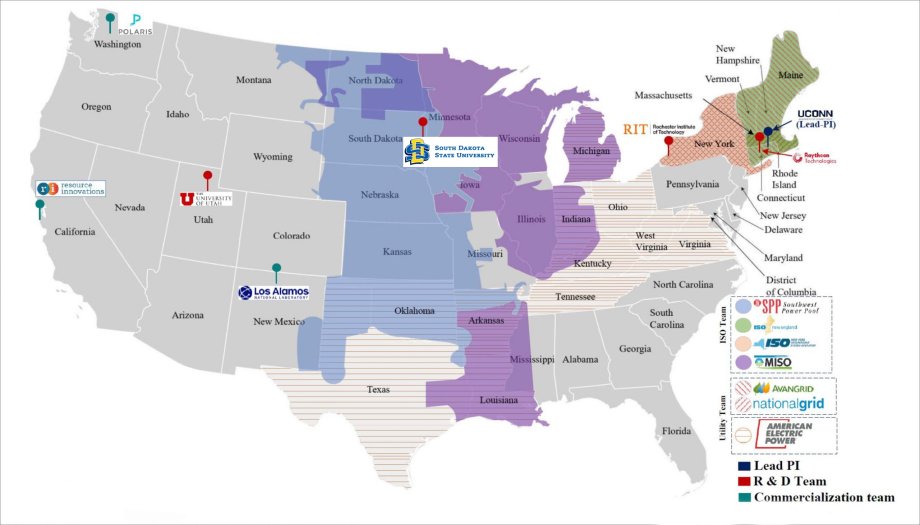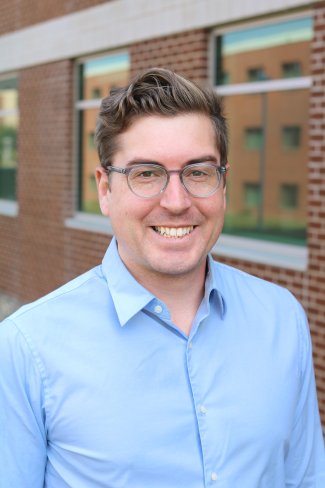
Tim Hansen, the Harold C. Hohbach Endowed Associate Professor in South Dakota State University’s Jerome J. Lohr College of Engineering, has been selected to help lead a groundbreaking initiative to revolutionize how power systems interact and adapt in an increasingly renewable energy-rich landscape.
“The ongoing global energy transition requires proactive solutions capable of harnessing resource flexibility under the uncertainty of renewable energy resources, such as solar, while fortifying the power grid’s reliability, resilience and sustainability — especially in the face of disruptions from severe weather and other high-impact events,” Hansen said. “This initiative will transform power grid operations and pave the way for large-scale deployment of clean energy technologies.”
The multi-disciplinary team is strategically located across the U.S. but will be led by principal investigator and project director Zongjie Wang from the University of Connecticut. The team also includes researchers from the University of Utah, the Rochester Institute of Technology, and Raytheon Technologies Research Center.

Historically, the U.S. electric grid has been operated at the “transmission level,” with independent system operators (ISOs) dispatching resources — like natural gas and coal — from large power plants to serve the electricity needs of its consumers. In such a model, the distribution system, including the one utilized by Brookings Municipal Utilities, is not visible nor controllable by the system’s operators. As distributed energy resources (DERs) — like rooftop solar power and battery storage — become more common and with the incorporation of the Federal Energy Regulatory Commission's Order No. 2222 from 2020, which allows distributed energy resources to be used in transmission system operations, how energy resources are allocated will improve dramatically through the work of this project.
Titled under the acronym “TRANSFORMATIVE” (Transmission and Distribution Systems with Flexible and Optimal Coordination: Resilience, Modeling, and Technologies for a VRE and DER-Integrated Adaptive Energy Grid), the research team seeks to develop the next generation of operation and planning tools that system operators need to efficiently use of distributed energy resources, utilizing data visualization to display information in their control rooms. The work will include advanced research and development to create optimization and coordination technology and a developed software tool for the first-of-its-kind coordinated operation of transmission and distribution systems that are crucial for realizing the goals of FERC Order No. 2222.
If successful, the project is poised to significantly enhance the grid’s capacity to utilize renewable energy, thereby accelerating the expansion and use of clean energy.
“Coordinating the operation of electric transmission and distribution systems is extremely challenging, both from a technical standpoint and a logistical standpoint. The former is challenging due to the inherent differences in modeling assumptions between transmission and distribution,” Hansen said. “We are overcoming this challenge through the technical prowess of our team leader, Dr. Wang, whose expertise is exactly in the area of transmission and distribution coordination, along with the modeling expertise available by our research collaborators at Los Alamos National Laboratory."
Hansen’s role in the project will be to model the availability and impact of distributed energy resources on the dispatch decisions made by control centers. With the help of two electrical engineering doctoral candidates, he will build a computer-solvable model to be integrated with the TRANSFORMATIVE tool to ensure transmission and distribution coordination is feasible. Additionally, he will model the impact of extreme weather on the availability of distributed energy resources to contribute to transmission-level services.
A key outcome of the project is to demonstrate the team’s developed tool in the third year of the project in the Southwest Power Pool control center, which manages a 50 GW electric grid from the Dakotas to the Texas Panhandle. To build and demonstrate the tool in such a short time, the team has strategic commercialization and software development partnerships with Los Alamos National Lab and Resource Innovations.
“I am greatly looking forward to seeing our TRANSFORMATIVE tool implemented in the Southwest Power Pool and other independent system operators in the near future to revolutionize U.S. power system operations,” Hansen said. “Under the leadership of Dr. Wang and with the strong TRANSFORMATIVE team and industry advisory board partners, I believe we truly can change the world.
The U.S. Department of Energy will provide approximately $4.5 million in funding for the full scope of the project, part of a larger $34 million investment from the federal government to address emerging challenges in power grid planning and operations.
The overarching goal of the investment is to increase the amount of renewable energy used in power systems, which will help in achieving a decarbonized electricity sector by 2035 — one of the U.S.’s primary sustainability goals.
- Contact:
- Telephone number: 605-688-6161
Republishing
You may republish SDSU News Center articles for free, online or in print. Questions? Contact us at sdsu.news@sdstate.edu or 605-688-6161.

